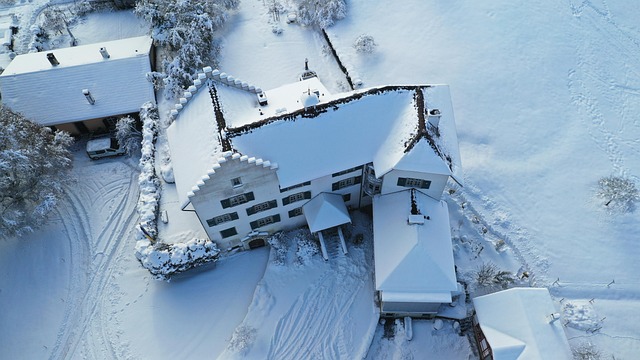Built-up roofing is a globally preferred, versatile system for flat commercial roofs, offering simplicity, cost-effectiveness, durability, and adaptability. This multi-layered system comprises a base sheet (asphalt/bitumen), fabric reinforcement (glass fiber or polyester mats), and a gravel or crushed stone coating. Each layer enhances the roof's strength, weather resistance, and performance. Ideal for urban commercial buildings, built-up roofing provides superior protection against harsh conditions, reduces maintenance needs, offers excellent insulation, and allows for customization with lighting and solar panels. Regular maintenance is vital to extend its lifespan through early detection of potential issues, ensuring cost-effective solutions.
Built-up roofing is a popular choice for flat commercial buildings, offering durability and cost-effectiveness. This comprehensive guide explores the intricacies of multi-layered built-up roofing systems, from their fundamental construction to the benefits they provide. We delve into the materials used, installation processes, and maintenance strategies that contribute to their longevity. Understanding these aspects is crucial for facility managers aiming to optimize roof performance and extend service life.
- Understanding Built-Up Roofing: A Comprehensive Overview
- Multi-Layered Construction: The Core of Built-Up Roofs
- Materials Used in Commercial Built-Up Roofing Systems
- Installation Process: Step by Step Guide to Built-Up Roofing
- Benefits and Advantages for Flat Commercial Buildings
- Maintenance and Repair Considerations for Longevity
Understanding Built-Up Roofing: A Comprehensive Overview

Built-up roofing is a traditional yet versatile system that has been a preferred choice for flat commercial roofs worldwide. This method involves layering multiple components to create a robust and durable protective barrier. The process starts with a base sheet, typically made of asphalt or bitumen roofing, which provides an impermeable foundation. Subsequent layers include fabric reinforcement, such as glass fiber or polyester mats, enhancing structural integrity and fire resistance. On top of these layers, a final coating of gravel or crushed stone is applied, offering additional protection against extreme weather conditions and providing a slip-resistant surface.
This multi-ply roof design is renowned for its simplicity and cost-effectiveness. The primary material, bitumen roofing, is readily available and relatively affordable, making it an attractive option for commercial property owners. Moreover, the gravel roof finish adds aesthetic appeal and provides insulation benefits. Built-up roofing systems are highly adaptable, suitable for various building structures and climates, ensuring longevity and reliable protection for flat roofs.
Multi-Layered Construction: The Core of Built-Up Roofs

Built-up roofing systems are renowned for their durability and versatility, making them a popular choice for flat commercial buildings. The core of this robust construction lies in its multi-layered design. Each layer plays a critical role in enhancing the roof’s strength, weather resistance, and overall performance.
These multi-ply roofs typically consist of successive applications of bitumen roofing and gravel layers. The base layer forms a solid foundation, while subsequent layers add thickness and protective barriers. Gravel roofs, for instance, provide a crucial water-repellent barrier, preventing moisture from penetrating the interior. This multi-layered construction ensures that any issues are mitigated, offering long-lasting protection for commercial structures.
Materials Used in Commercial Built-Up Roofing Systems

Commercial built-up roofing systems are renowned for their durability and versatility, thanks to a combination of robust materials. These multi-ply roofs typically consist of several layers, each serving a specific purpose. The foundation layer is usually a heavy-duty fabric or synthetic membrane, providing a protective barrier against moisture and ultra-violet rays.
Above this, bitumen roofing plays a critical role in sealing the system, creating a waterproof envelope. This is often topped with a gravel roof, which not only adds extra protection but also acts as a weight-bearing layer, crucial for the structural integrity of flat commercial buildings. The combination of these materials creates a strong, reliable roof that can withstand the rigours of urban environments.
Installation Process: Step by Step Guide to Built-Up Roofing

The installation process for built-up roofing systems involves several meticulous steps to ensure a durable and weatherproof finish for flat commercial buildings. It begins with preparing the substrate, which includes cleaning and inspecting the roof deck to guarantee it’s free from any debris or defects. A primary layer of bitumen roofing is then applied, creating a sticky surface that binds subsequent layers together. This initial coat serves as a crucial foundation for the multi-ply roof.
Successive layers of gravel roof are carefully added, each separated by additional coats of bitumen. The number of plies varies based on the system’s design and local building codes. Proper alignment and overlap of each ply are vital to prevent water infiltration. After the final layer is secured, a protective membrane or flashings may be installed around roof perimeters and penetrations for added strength and sealant. This step-by-step guide ensures that every aspect of the built-up roofing system is correctly executed, contributing to its longevity and reliability under varying weather conditions.
Benefits and Advantages for Flat Commercial Buildings

Built-up roofing systems, often referred to as multi-ply roofs or bitumen roofing, offer a multitude of benefits specifically tailored for flat commercial buildings. One of the primary advantages is their superior durability and longevity. By layering multiple components, including fabric membranes and asphalt or bitumen, these systems create a robust barrier against harsh weather conditions, such as rain, snow, and intense UV radiation. This protective layer ensures the building’s structural integrity remains unharmed for extended periods, significantly reducing maintenance needs and costs over time.
Moreover, gravel roofs constructed using built-up roofing techniques provide excellent insulation, contributing to energy-efficient operations. The dense packing of gravel acts as a natural insulator, mitigating temperature fluctuations inside the building. This property not only reduces the load on HVAC systems but also helps in achieving better indoor comfort year-round. Additionally, these systems offer versatile customization options, allowing for the integration of lighting fixtures or solar panels, further enhancing the functionality and sustainability of flat commercial spaces.
Maintenance and Repair Considerations for Longevity

Proper maintenance and timely repairs are essential for extending the lifespan of built-up roofing systems, a common choice for flat commercial buildings due to its durability and cost-effectiveness. Regular inspections are crucial to identify any signs of damage, such as cracks, blisters, or missing components. These issues can often be resolved through simple repair methods like replacing damaged sheets, reapplying bitumen coating, or adding fresh gravel to the surface.
One of the key benefits of built-up roofing is its multi-ply design, which provides enhanced protection against environmental factors. By addressing repairs promptly, building owners can maintain this protective layer, preventing water intrusion and ensuring the structural integrity of the building below. Regular maintenance also allows for the early detection of potential problems, making it easier to implement cost-effective solutions before more extensive—and expensive—rehabulations become necessary.
